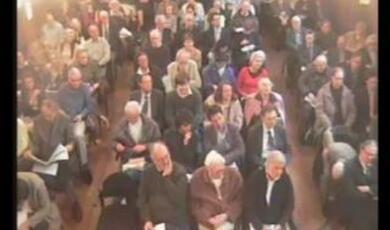The Future of London Government: Continuous Revolution
Share
- Details
- Transcript
- Audio
- Downloads
- Extra Reading
Professor George W Jones turns his attention to possible future reforms of London's governing structure, questioning the very idea of "Government" itself.
Download Transcript
24 May 2010 Continuous Revolution - The struggle to reform London's government Professor George W Jones Objective Tony Travers has presented the history of attempts to reorganise London's government up to today. I've been asked to look at possible future reforms to the structure. The two main messages of my paper are: there is no "Government of London" - there is the governance of London by many separate organisations and people. And there is no one right way to organise the government of London. Context Greater London is the biggest urban area in the UK, covering 609 square miles [1579 square km] and containing 7.5 million people, within a wider Greater South East region of 19 million. The population has grown in recent years at the rate of between 50,000 to 100,000 a year. It is a major centre of immigration: 30%+ of the population are non-white and 30%+ immigrant; and 300 languages are spoken. It produces about 20% of the UK's gross domestic product. Socially it exhibits great disparities of wealth and poverty. A number of significant parts of the London need regeneration, largely because of de-industrialisation. The current financial crisis is likely to lead to further change in its economy and some social distress. History As Tony has shown the history of London's governmental system reveals a relentless search for a right solution, but it has never been found. The fundamental tension is between centralisers and decentralisers: the former emphasize the need for a governing authority to encompass the whole of London, while the latter emphasize the need for the parts of London to have their own governing bodies. A related problem is to devise for a wide range of public services an appropriate relationship between policy-making - the strategic function -, and implementation - the executive function. Another relationship adds a complicating dimension to London's governance: the influence of central government, reluctant to concede self-determination to its capital city. Into this mix of pressures and tensions a new dynamic was introduced in 2000: the establishment of a mayor for London, the UK's first directly-elected executive mayor. Tony Travers produced in his book The Politics of London (Basingstoke: Palgrave Macmillan, 2004) at pages 186-187 a diagram of the maze of London Government, and at page 185 states: "This extraordinary muddle of overlapping and often competitive institutions is every bit as bad as the chaos of London's Victorian administration. Slow decision-making and weak government are the inevitable consequence." The big issues Given the history of instability in London's governmental arrangements, the future will be similarly unstable. To achieve any reform will be a struggle, because of the different views of the different interests involved. Analysis of London's government raises three major structural problems: 1) What is London? The first question that remains open is whether the boundaries of the GLA are "right", which raises the question of what is London? For some the GLA is too small, not covering the area inside the M25 motorway box, or indeed built-up "London", and well short of the area economically dependent on London which should encompass at least the Greater South East region. For others it is too large, covering in its outer reaches areas once in Essex, Kent, Middlesex and Surrey, many of whose inhabitants do not feel they are Londoners. 2) What to do with the boroughs? The second question is whether the lower tier of boroughs is too many or too few. Formed in 1965 they often reflect no local community clearly identifiable to local people, and yet seem too small to provide their services as efficiently as local people desire. Some are artificial amalgamations of previously separate authorities to which some of the public still feel attached. Ken Livingstone who was unsympathetic to the boroughs had plans to merge the 32 into 5 wedge-shaped triangles whose points converged in the centre of London, joining together rich and poor areas and following the radial road routes. His aborted plan and the present boundaries leave without a distinct governmental body the part of London that people all over the world identify as London, with its iconic buildings and monuments, its famous roads and railway stations, - the heart of London. This central core is splintered, lying partly within 10 boroughs, called in technocrats' jargon the "Central Activities Zone" [CAZ], an area of 13 square miles, with a residential population of 280,000, having 30% of London's employment. This area, real London, has no single local government unit of its own. The institution closest to a government of this central London area is Central London Forward, established in 2007 by seven of the boroughs in CAZ to promote the case for central London in the absence of a formal Central London sub-region, and to lobby on behalf of central London. Its latest publication, The case for central London, makes no mention of how central London might be governed. Indeed, its constituent authorities would be likely to be most unenthusiastic if it did. The City of London remains a glaring anomaly, with its mediaeval government of the City Corporation, Lord Mayor and Aldermen, its unique electoral arrangements which allow both residents and businesses to vote, its antique wards, its own police force separate from the Metropolitan Police, and its great wealth as London's financial powerhouse - really a glorified central business and financial district. It was said by an earlier official commission that the City of London shows that logic has its limits and that the City lies outside them. 3) What if anything to put below the boroughs? The third question is what governmental arrangements, if any, should exist below the boroughs. The rhetoric of all political parties is to champion localism and decentralisation to something below the bottom tier of local government - to communities or, less amorphously, to urban parishes. So the most advanced thinking is to return to the nineteenth century. In its 2005 manifesto, the Labour Party put forward a proposal to introduce urban parishes across London. Models for Reform Thinking up plans to reorganise the government of London is a great game. In the 1990s Tony Travers of the LSE and I devised 8 options for reforming the then London government [Tony Travers and George Jones,The New Government of London (York: Joseph Rowntree Foundation, 1997), pp. 116-135]. A powerful London regional authority which would take control of services from central government. A London regional authority, as above, with a directly-elected mayor. An elected transport authority for the South East, leaving the boroughs largely unchanged, as would be so with the two previous options. An indirectly-elected advisory committee for the London region, leaving the boroughs largely unchanged but with neighbourhood (parish) councils if locally desired. Keep the present system but central government to appoint a minister for London. Expand the City of London. Keep the present system but add a Central London Planning Agency. No fundamental change, save for some minor agreed improvements. I have often argued for the establishment of a unitary [all-purpose] authority, following more or less the boundaries of the old London County Council, and a number of unitaries encircling this new central London authority. All these unitaries would select a Senate for the South East Region to advise central government about its major planning, infrastructure and transport decisions. Beneath the unitaries could be neighbourhood or parish councils wherever a majority of local people wanted them and were prepared to pay for them. When Tony Travers and I wrote our study in the 1990s there was no GLA, indeed no all-London authority. The GLA that came about in 2000 was aregional or metropolitan authority, not a local authority, and more similar to the devolved arrangements for Scotland [population 5 million], Wales [population 3 million] and Northern Ireland [under 2 million]. Local government in London is mainly in the hands of the boroughs, which have an influential organisation, London Councils, representing, protecting and promoting their interests. Some may still wonder whether we should not abolish the GLA and turn to a body representing the boroughs (possibly a 'senate of Leaders') to act as the Government of London - yet another possible model. Ken Livingstone indeed proposed replacing the London Assembly with such joint borough institution. We can all play with our models, which can be pulled out when the desire to tamper with the governmental arrangements of London or of any metropolitan area, comes around again, as it surely will. Concluding thoughts: London faces periodical reorganization of its governmental arrangements, because there is no one right solution, but people still think there is one around the corner. The City of London has continued and will continue. The directly-elected mayor is a radical innovation, but whether one-person rule is better than collegial-cabinet rule will be apparent only after some years. Despite weak and confusing governmental arrangements London has continued to evolve and prosper, attracting people and investment. Indeed, those who develop the city, ranging from land-owning aristocrats to modern property developers, are by far the most important determinants of London's long-term shape and economic strength. Would more rationally-organised and stronger government ruin it? Perhaps the best way ahead is not to reform London's government. To embark yet again on reform would be a costly and divisive venture, and a great distraction from tackling big problems that lie ahead. London's economy is significantly exposed to recent and current financial problems arising from the banking crisis and the economic downturn and recession. London's growth and prosperity is likely to falter in the short term, though evidence thus far suggests London has been less badly hit by the recession than the UK as a whole. London's social problems are likely to intensify. What is the best way to deal with these intractable economic and social problems? Since no one knows, it is better not to rely on action by central government but to let many local authorities try out their own approaches that suit the conditions of their localities. Some believe there is a need to diversify London's economy - in manufacturing, tourism, culture, health, and education. Any recovery plan should be based on letting local authorities and local businesses experiment and not on central government telling them what to do. Is such local action the way ahead, or should London persist in grand projects like Crossrail and the Olympic Games? Or both? London is a rich place that pays far more in tax than is spent on it. Devolved fiscal freedom would allow more decisions about the city to be made by local politicians. A great city like London should not have to go begging to central government for funds. London should be governing itself, responsible for shaping its future development and accountable to its citizens. It should not be regarded as just an agent or instrument of central government. The new Coalition Government promises to abolish the Government Office for London, which would be yet another stage in the continuous revolution of London's governance. © Professor George W Jones, 2010
Part of:
This event was on Mon, 24 May 2010
Support Gresham
Gresham College has offered an outstanding education to the public free of charge for over 400 years. Today, Gresham plays an important role in fostering a love of learning and a greater understanding of ourselves and the world around us. Your donation will help to widen our reach and to broaden our audience, allowing more people to benefit from a high-quality education from some of the brightest minds.


 Login
Login






